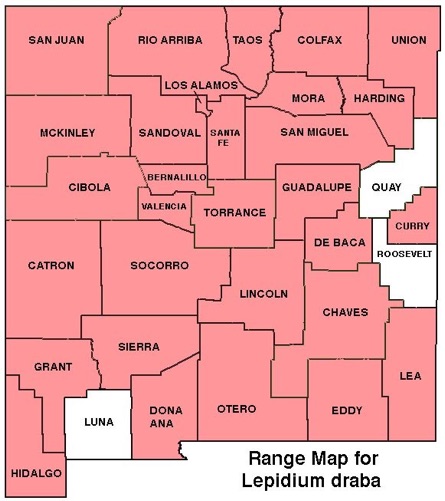WILDFLOWERS OF NEW MEXICO

Listed as a Class A Noxious Weed in NM (limited distribution, eradicating existing infestations of highest priority) and much of the West, this showy mustard spreads by rhizomes and can form 5-foot wide colonies with 2-foot tall branching stems, hairy or not. Note the large, showy clusters of small white flowers with 4 petals, the flat, heart-shaped seed pods, and the broad, clasping stem leaves.
FLOWER: April–July. Dense, flat-topped clusters on branch ends cover the top of the plant; 4 white, oval petals, each 1/8–3/16 inch long (3–4 mm); 6 stamens; fruit pods on short stalks, heart-shaped with notched to rounded tip. Each plant can produce up to 5,000 seeds.
LEAVES: Basal leaves usually wither by flowering, stem leaves alternate. Blade elliptic to lance-shaped, 3/4–4 inches long (2–10 cm), stalkless (sessile), lower wrapped around stem, upper clasping; surfaces hairy or not, margins entire, toothed, or wavy.
HABITAT: Sandy, gravelly, loamy soils; riparian areas, roadsides, irrigated fields, pastures, ditches, disturbed areas.
ELEVATION: 3,800–7,800 feet.
RANGE: Widespread in the West, scattered across northern U. S.
SIMILAR SPECIES: Three other nearly identical invasive Whitetops with slightly different shaped seed pods, L. chalepense, L. campestre, and L. appelianum, are widespread in the West, but have limited distribution in NM, mostly in northern counties.
NM COUNTIES: Nearly statewide in NM in mid-elevation disturbed habitats: not reported in Luna, Quay, Roosevelt.

HOARY CRESS, WHITETOP
LEPIDIUM DRABA (CARDARIA DRABA)
Mustard Family, Brassicaceae
Perennial herb; introduced, invasive


THE CONTENTS OF THIS WEBSITE ARE COPYRIGHTED AND CANNOT BE USED
WITHOUT PERMISSION OF GEORGE OXFORD MILLER
EMAIL ME


Flat-topped flower clusters cover the branch ends, providing one of the common names, Whitetop.
Leaves often have wavy edges.
Plants spread by rhizomes and can form clumps 5-feet wide.
